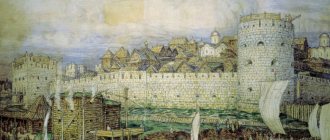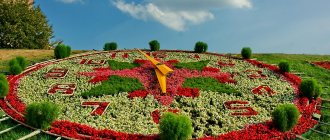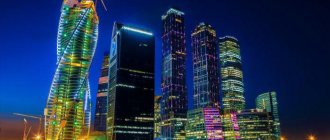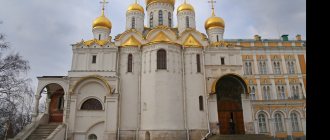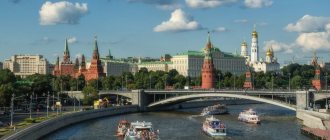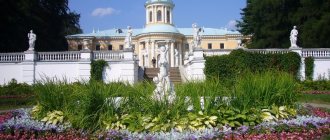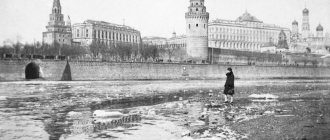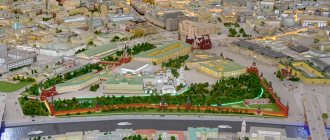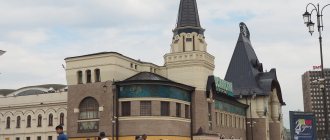Memory of Moscow lands
Archaeological excavations show that the territory of modern Moscow and the Moscow region has been inhabited since ancient times.
The earliest finds - stone and bone axes, knives, fishhooks and arrowheads - traces of the so-called Lyalovo culture - are attributed by experts to the Neolithic era (the later period of the Stone Age). For example, on the territory of the village of Dyakovo (now the Kolomenskoye Museum-Reserve), a primitive site dating back to the 4th millennium BC was discovered [1], and in the Orekhovo-Zuevsky district - almost a thousand years older [2]. The Fatyanovo culture marks the transition to the development of metal. In the Moscow region, for example in Istra and Iksha, archaeologists have studied many burial grounds (burials) from the end of the 3rd millennium BC. Thus, it became known that nomadic herders lived here, who used tools and jewelry made of bronze [1].
Obvious signs of sedentary life are demonstrated by the monuments of the Dyakovo culture, which archaeologists date back more than a thousand years - from the 7th century BC to the 7th-8th centuries AD. The bones of domestic animals, iron sickles and grain graters indicate that Finno-Ugric tribes, such as the Merya and Ves, were actively engaged in agriculture and cattle breeding [1].
Finally, scientists attribute the earthen mounds of the 10th–11th centuries to the Slavic tribes: on the lands of modern Moscow the Vyatichi lived mainly, and in the north of the present Moscow region, above Klyazma, the Krivichi [1].
Traces of Slavic settlements are found in almost all areas with access to water: Dyakovo, Fili, Kuntsevo, Matveevsky, Brateev, Zyuzin... The oldest Moscow house is considered to be the dwelling of a Vyatichi artisan, discovered near the modern Patriarchal Chambers of the Kremlin [1]. It was probably part of a complex of buildings surrounded by a triangular ditch, which was filled in at the beginning of the 12th century. Archaeologists discovered its outline near the current Grand Kremlin Palace [2].
Referring to chronicles and legends, some historians even list the names of Vyatichi settlements, in which the names of such modern districts as Vorobyovo, Vysotskoye, Kulishki, Kudrino, Simonovo, Sushchevo are recognizable.
Origin of the name of the capital
Ancient chronicles preserved two names of the city - Kuchkovo and Moskova. The first name is explained simply - by the name of the original owner, Stepan Kuchka. The second name has several scientific explanations, but none of them can be called accurate.
Polish Slavic scholar and historian Zorian Khodakovsky suggested that the word “Moscow” is derived from “bridge.” Modern scientists consider this version unlikely. Moscow was called not only the city, but also a large river. That's why they say that the city is named after the river. The linguistic tradition of Rus' knows many examples when a city was named after a river, but not vice versa. The story “about the beginning of Moscow” also claims that Prince Yuri named the city after the river.
Small rivers, lakes and streams on the territory of the capital bear Old Russian names. Large bodies of water have names unusual for Slavic languages - Ruza, Pakhra, Nudyl. Historians believe that such toponyms remained from the people who lived on the territory of the modern capital before the arrival of the Slavs. The meanings of these terms, including the word “Moscow,” have not yet been deciphered.
Chronicles: facts and questions
The Ipatiev (Kiev) Chronicle is considered the most authoritative source on the issue of the “paternity” of the future capital - it contains the first reliable mention of Moscow:
“In the summer of 6655. Gyurga went to fight the Novgorochka volost, and came to take the New Trade and take all the revenge; and Yuri came to Svyatoslav and ordered him to fight the Smolensk volost; and Svyatoslav marched and took the people of Golyad, the top of Porotva, and so Svyatoslav’s squad was swarmed. And Gyurgi sent a speech: “Come to me, brother, in Moscow.” Svyatoslav rode to him with his child Olg, in a small squad, taking Volodyamer Svyatoslavich with him; Oleg rode ahead to Gyurgevi, and let him be forgiven. And his father Svyatoslav came for him, and so kindly kissed, on the day of heels, to the praise of the Holy Mother of God, and so there was joy. On the morning of the day, Gyurga commanded to arrange a strong dinner, and do great honor to them, and give many gifts to Svyatoslav, with love, and to his sons Olgovi and Volodymyr Svyatoslavich...” [1].
According to ancient tradition, the year 6655 was counted from the creation of the world; in modern chronology this is the 1147th. Prince Yuri (George) Dolgoruky, son of Vladimir Monomakh, just invites another prince, Svyatoslav Olgovich, to a feast. Neither the status of the settlement nor the prince’s attitude towards its origin are indicated in any way.
These moments are revealed by another source - the Tver Chronicle: “In the same summer (1156) the Great Prince Yuri Volodymerich founded the city of Moscow on the Neglinnaya river above the Yauza River.” That is, the prince built a fortress; judging by archaeological excavations, it occupied the southwestern corner of the modern Kremlin [1].
The catch is that historians trust this source much less: the earliest surviving copy of the Ipatiev Chronicle dates back to the 15th century, and the Tver Chronicle to the 16th century. There is information that in 1156 Yuri Dolgoruky was in Kyiv and could hardly have been involved in construction on Moscow lands. This gives reason to believe that in fact the fortress was founded by Yuri’s son, Andrei Bogolyubsky [1].
Ivan groznyj
This ruler played a significant role in the development of Moscow culture. He entered the history of Russia as the first Russian Tsar. In 1547, Metropolitan Macarius proclaimed Ivan IV the Russian autocrat and placed the Monomakh cap, one of the symbols of power, on his head.
The king was a tyrant, but this did not stop him from becoming one of the most educated people of the era. In the 50s he founded the Printing House. He had a huge collection of books for those times. After another mass execution, Ivan the Terrible donated significant sums to monasteries. However, during the years of his reign, many priests and monks died.
City's legends
There are other versions of the appearance of Moscow. A branch of works under the general title “The Legend of the Conception of Moscow and the Krutitsa Bishopric” appeared at the end of the 17th century. Here, the clearly fictional prince Daniil Ivanovich is looking for a place to found a royal city. In the forests he meets a spotted beast with three heads. The prince's adviser, the Greek Vasily, interprets this meeting as a sign: the kingdom will be triangular, inhabited by a variety of people. On the territory of the future city, two points are identified: the island where the hermit Bukal lives becomes the site of the royal court (fortress), and the hill where a certain Roman Podon lives becomes the site for the Krutitsky monastery. The city was founded in 6720 (1212) [5].
Although the “Tale” contains a lot of fiction, a historical grain is also present in it: the creation of the Krutitsy metochion is attributed to Prince Daniil of Moscow precisely in the 13th century.
But this “box” of Moscow legends does not end there! There is also “The Legend of the Founding of Moscow by Oleg,” or “The Beginning of the Reigning City of Moscow,” which researchers also date back to the second half of the 17th century. In it, the governor of Rurik, Prince Oleg, is declared the founder of Moscow, and the event itself is dated to the year 6388 (880). After Oleg, Igor Rurikovich became the prince of all Russian lands. The narrative, compressed to the limit, literally emphasizes a very important point (for the establishment of princely power): the unknown author notes that Igor descends from the “Caesar of Rome” Augustus [5]. Thus, there is no longer even a need for the formula: Russia is actually called the heir of Rome.
Moscow in the Great Patriotic War
During the Great Patriotic War of 1941, when Nazi troops were rapidly advancing across the territory of the Soviet Union, the threat of capturing Moscow once again caused a tremendous patriotic outburst in people. Moscow was the heart of the state, its stronghold; not giving Moscow up to the enemy became the main goal for Soviet soldiers. The defenders of Moscow and Tula, which was the last defensive point in the south, were able to stop the advance of German troops, and from that moment the counter-offensive of the Soviet Army began. In the battle for Moscow, Hitler’s army suffered its first major defeat, and the beginning was laid for the defeat of the fascist invaders and the liberation from fascism not only of the USSR, but also of Europe. In 1965, Moscow received the title of Hero City as a sign of respect for the city residents who showed courage and heroism in the struggle for its liberation.
In the post-war years, Moscow began to quickly recover. City residents returned from evacuation, the number of educational institutions increased, Moscow began to recover and grow at an amazing pace. In 1956, construction began on the Moscow Ring Road near the Yaroslavl Highway. In 1960, the first section of the road was opened, and in 1962, traffic was allowed along the entire ring. At first, the Moscow Ring Road served as the border of the Moscow urban area; now the capital of Russia has expanded beyond the ring.
Disputed date
Although the legends listed are literary monuments, historians have paid a lot of attention to them. The first mentions of these texts are found in Vasily Tatishchev. Nikolai Karamzin disparagingly called them fairy tales. But Ivan Zabelin, one of the first directors of the Historical Museum, was not so categorical: he believed that there was a certain rational grain in the legends [5].
But even without legends, historians have something to argue about. In addition to 880, 1147 and 1156, sources allegedly based on chronicles also mentioned other dates for the founding of Moscow, for example 1117 and 1140. This confused few people for the time being, or rather, until the 1840s. The first serious discussion arose in connection with the upcoming 700th anniversary of the city and took place on the pages of Moskovityanin, Moskovskie Vedomosti and other periodicals [6, 7].
However, it was serious more in the intensity of passions than in its subject matter. Karamzin in the “History of the Russian State,” in accordance with the Ipatiev Chronicle, authoritatively declared the year 1147 to be “correct.” Moreover, he named the exact date of the meeting of the princes - March 28 (the Feast of the Praise of the Virgin Mary). Professor I.M. was the first to decide to challenge it. Snegirev: citing shifts in the church calendar, he “moved” the event to April 5. Karamzin’s version was supported by M.P. Pogodin and A.I. Herzen, Snegirev’s version - his student P.V. Khavsky and young Ivan Zabelin. The dispute actually ended in nothing: by decree of Emperor Nicholas I, Moscow modestly, almost imperceptibly, celebrated the anniversary... on January 1, 1847 [6, 7].
At the end of the 19th century, historians no longer actually argued, but adhered to democratic pluralism - everyone expressed their point of view. Some researchers were impressed by the version of the founding of Moscow by Prince Oleg [3], others called it “an invention of later scribes” [8].
Moscow celebrated the next anniversary, the 800th anniversary, in September 1947. Historians again found themselves out of work: the date was personally set by Joseph Stalin, and there was no one willing to argue with the “father of nations.” The tradition was revived in 1997, and since then the holiday has become an annual event.
Science does not stand still: archaeological excavations in different areas of Moscow are still ongoing, and new artifacts give rise to continued discussion about the age of the city. For example, a settlement discovered on the territory of the Danilovsky Monastery dates back to the 9th century; Traces of buildings found near Red Square also date back to the 9th–10th centuries. The ancient Arab coins found also raise many questions. All this makes some researchers say that Moscow may be 200–300 years older than the generally accepted version established by Karamzin [9, 10].
More cautious or skeptical scientists ask to keep a few important points in mind. Firstly, the concepts should be differentiated. If a group of buildings is enough for a settlement, then a city requires something more - the presence of defensive structures, at least ramparts and ditches, and minimal infrastructure, in modern terms, for example, pavements [10].
Secondly, the creation of the city must be considered as a cultural and political fact. In medieval Eastern Europe, only a prince could assign city status to a settlement. As a rule, such an important event was noted in chronicles, which is why they are considered the main source on “administrative” issues [4].
Muddy river or meandering river?
If the name Moscow comes from the Baltic languages, then its source could be the Baltic forms *Mask-(u)va, *Mask-ava or *Mazg-(u)va, *Mazg-ava (Latvian Maskava). The root *mask-/*mazg- could be associated both with swamp, mud, and with the “knot” (mazgas in Lithuanian), washing by the river from the verbs “to wash, rinse” (Lithuanian mazgoti, Latvian moskat).
Accordingly, the origin of the name can be traced back to both the marshy, dirty terrain - which is consistent with the Slavic hypothesis - and to the tortuosity of the Moscow River - only within the city it makes 11 large loops.
Moscow River. Photo: www.globallookpress.com
Used sources
- Kantorovich I.V. From the history of Moscow. - M.: MIROS, 1997. - P. 5–22.
- Veksler A.G., Melnikova A.S. Moscow treasures. - M.: Moscow worker, 1988. - P. 26–56.
- The Hoary Antiquity of Moscow: Historical Review and Complete Index of Its Sights / Comp. I.K. Kondratiev. — M.: I.A. Morozov, 1893. - pp. 3–6.
- Kuznetsov A.A. Prince of Vladimir Georgy Vsevolodovich (1188–1238). Source study, history, historiography (dissertation). - Izhevsk: Udmurt State University, 2009. - pp. 289–299.
- Stories about the beginning of Moscow / Research and preparation of texts by M.A. Salmina. - M., L.: Nauka, 1964.
- Naek E.L. Domestic chronology of the end of the 18th century. — 1991: historiographical experience (dissertation). - M.: Moscow State Regional University, 2010. - P. 164–165.
- Kaygorodova T.V. Scientific historical and chronological knowledge in Russia in the 18th - early 20th centuries (dissertation). - Barnaul: Altai State University, 2012. - pp. 135–139.
- Nazarevsky V.V. Moscow is the heart of Russia. Eight centuries of history. - M.: AST, Astrel, 2008. - P. 7–21.
- Tyunyaev A.A. How old is Moscow? On the issue of disputes between archaeologists and chroniclers // Russia and the modern world: Scientific journal. - M.: RAS, INION, Institute of Economics, 2011. - No. 1 (70). — pp. 172–178.
- Vazhdaeva N. My elderly capital // Results. - 2012. - No. 37 (848). — pp. 78–79.
Modern Moscow
After the USSR ceased to exist in 1991, Moscow became the capital of Russia, and since 1993 - a city of federal significance. The Kremlin has become the residence of the President of Russia and a place visited by a large number of tourists (museum areas).
In the 21st century, Moscow has been gripped by a grandiose architectural transformation, which threatens the almost complete destruction of historical and architectural monuments. Since the restoration of dilapidated ancient buildings is not only troublesome, but also very expensive, they are often declared unsafe, and new buildings are erected in their place. Due to the fact that the most prestigious and expensive plots of land are located in the historical center of Moscow, it suffers first of all; in addition, the term “infill development” has appeared, which was officially banned in 2008.
Among the problems of today's Moscow is transport - frequent traffic jams force residents of the capital to lose a lot of time moving around the city, especially during rush hours.
But still, today's Moscow has something to be proud of. Large forests and parks have been preserved within the city limits, including: Losiny Island, Izmailovsky Park, Timiryazevsky Park, Botanical Garden, Neskuchny Garden, Bitsevsky Forest Park.
Moscow is still the theater capital of Russia. There are more than one and a half hundred theaters in Moscow, including world-famous ones such as the Bolshoi Theater, and small private studio theaters and experimental theaters.
The huge number of museums existing in Moscow is second only to such large cities as New York and Madrid. The largest museums in Moscow: State Museum of Fine Arts. A. S. Pushkin and the Tretyakov Gallery.
In addition, Moscow is a major scientific and industrial center. Scientific branches developed especially actively during the Soviet period. It was then that many research institutes appeared in Moscow that were engaged in research in the field of nuclear energy, microelectronics, and astronautics.
Religion is an important area of people's lives. Moscow is very tolerant in this regard. More than 1,000 religious associations are officially registered in the city, representing more than 50 denominations of different faiths.
All major world religions are represented in Moscow. Officially, more than 1,000 religious associations and organizations are registered in the city, representing more than 50 different religious denominations.
In addition to an extensive network of bus, trolleybus and tram routes, minibuses and taxis transport passengers in Moscow. The main load is borne by the Moscow metro. There are airports in Moscow: Domodedovo, Sheremetyevo, Vnukovo and Bykovo, as well as 9 railway stations. During the navigation period, river trams and cruise ships operate along the Moscow River, and the Southern Port receives cargo ships.
Time of Troubles
After the death of Boris Godunov, Moscow rulers were replaced one after another. The city fell into the hands of the Poles. Patriarch Hermogenes stated that if Vladislav Sigismundovich does not accept Orthodoxy, he will have to abdicate the throne. But the Polish prince was not satisfied with such conditions - he was a fanatical Catholic. Then the patriarch sent letters throughout the state calling for the fight for the liberation of Moscow. The militia was led by Dmitry Pozharsky and Kozma Minin. In 1818, a monument was erected to the people's hero on Red Square.
Khitrovka
Vladimir Gilyarovsky spoke about what the capital of Russia looked like at the beginning of the 20th century. One of the chapters of the book “Moscow and Muscovites” is called “Khitrovka”. It is dedicated to a terrible area that has become part of the history of Moscow. Crowds of ragamuffins, thieves, and bandits roamed the streets of Khitrovka day and night. To travel through this area meant dooming yourself to meet with robbers and, possibly, losing not only your things, but also your life. Today, on the site of the Khitrovsky shelters there are shops, restaurants, and office centers.
Soviet time
Nine years after the tragedy on the Khodynskoye Field in Moscow, street battles took place. After 12 years, a revolution occurred and the king was overthrown. The new government returned the city to the status of the capital.
In the first half of the 20th century, a huge number of new residential buildings appeared. If in the 20s most Muscovites lived in barracks and communal apartments, then after the war almost all of them received new housing. In addition, new highways were built. True, some of the architectural monuments were demolished during the Soviet years. This is a brief history of Moscow - one of the largest and most disorderly cities in the world.
There are many preserved architectural monuments in the capital. You should start getting acquainted with the city from the Kremlin. Tours are offered here all year round. Rare exhibitions are presented. One of the oldest cultural institutions in the Russian capital is the Moscow History Museum, located near the Park Kultury metro station.
